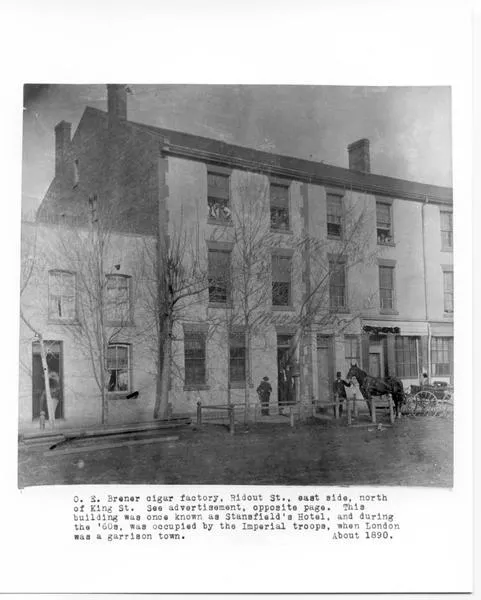Date of Plaque Unveiling: 19 September 2001
Speakers: Mike Baker
Location: 184 Horton Street, London, ON (present site of the Boys and Girls Club)
History
Cigar manufacturing has a long and rich history in the London area. In the years before the First World War, London was the second largest producer of cigars in all of Canada, only slightly behind Montreal.
Prior to the beginning of Canadian cigar manufacturing, most of the cigars sold in Canada were imported from Germany. In the late 1800s, Otto E. Brener, a German immigrant residing in London, Ontario, began making his own cigars. Though it is unclear exactly when he began his operation, Brenner listed his occupation as a cigar maker as early as 1881.
His first business was located on the west side of Wellington Street between Bathurst and Horton. Brener worked out of this location for several years before moving his operation to the west side of Richmond Street, just south of King.
By 1886, he had once again relocated, this time to 384 Ridout Street, a former hotel and military garrison building. At the time of this move, Brener Brothers employed some thirty workers.
Over the next few decades, Brener’s cigar manufacturing would grow and thrive in the London area.
By 1891, Otto’s two sons, Otto E. and Arthur H., had joined him in the family business. As the company grew in size, Brener Brothers decided to relocate their cigar factory one final time to 184-190 Horton Street. It was at this location that Brener Brothers found their greatest success.
It has been estimated that London’s highest cigar production came in the years between 1910 and 1912. Some accounts report that on average the city of London produced up to eighty million cigars during this time, a number that would drop to around twenty million in the years after the end of the First World War.
As one of London’s larger cigar producers at the time, Brener Brothers had expanded their workforce from thirty to two hundred and produced roughly ten million cigars in 1912. Their success, however, would be short-lived, for the post-war years would see the decline and eventual closure of Brener Brothers.
The First World War saw the prohibition of the sale of alcohol of any kind, putting many bars, the main place cigars were sold, out of business. As well, after the War, cheaper cigarettes replaced cigars as the smoke of choice.
These events led to a downturn in cigar production and by 1922 the Brener Brothers Company was no more. In the 1970s, the Brener Brother’s former factory on Horton Street became the home of the Memorial Boys’ and Girls’ Club of London.

